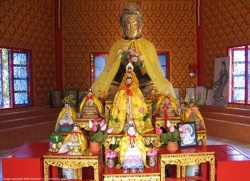Tathāgata-garbha
Click here to see other articles relating to word Tathāgata-garbha
Tathāgata-garbha [ - ] Tathāgata-garbha; Tathagatagarbha; is the embryo of the Buddha. It is one of the most important concepts in the Mahāyāna. It means that the inherent nature of all living beings is to attain enlightenment. The element of Buddhahood (Buddha-dhātu) is the intrinsic, eternal, and true nature of all living beings. Hence all living beings are intrinsically Buddha-s. The Tathāgata-garbha theory is based on the Ratnagotra vibhāga (also known as the Uttaratantra) ascribed to Maitreya. Some scholars ascribe it to Asaṅga.
According to the Mahāyāna Mahāparinirvāṇa Sūtra, the Tathāgatagarbha is the true self of living-beings. In the Mahāyāna Tathāgatagarbha Sūtra, the Buddha says, "When I regard all beings with my Buddha eye, I see that hidden within the kleśa-s of greed, desire, anger and stupidity, there is seated augustly and unmovingly -- the Tathāgata's vision, and the Tathāgata's body ... All beings, though they find themselves with all sorts of kleśa-s, have a Tathāgatagarbha, the eternally unsullied, and replete with virtues not different from my own."
The notion of Tathāgata-garbha is predominant in Zen Philosophy.
Page: Mahāyāna-Sūtrālaṅkāra. IX. 43.
tathāgata-garbha
(Sanskrit). The ‘embryonic Buddha’. A Mahāyāna concept which holds that all beings inherently possess the potential to become a Buddha. According to this view, the negative elements that bind an individual to saṃsāra are adventitious (āgantuka-kleśa) and merely conceal or veil the underlying pure Buddha-nature. The Tathāgata-garbha doctrine is based on a set of ten sūtras that teach this concept, such as the Tathāgata-garbha Sūtra, the Śrīmālā-devi-siṃhanāda, and the Nirvāṇa Sūtra, as well as the treatise attributed to Sthiramati or Maitreyanātha, the Ratna-gotra-vibhāga, though it has a historical antecedent in the early Buddhist concept of the intrinsically luminous mind.
According to the position adopted by these sūtras, the Tathāgata-garbha is a real and eternally existing essence that is primordially replete with all the qualities of a Buddha. The concept was understood slightly differently in the Tibetan and the Chinese traditions where the term is translated as ‘Tathāgata embryo’ and ‘Tathāgata womb’ respectively. The term is also used synonymously with ātman and gotra in a number of these texts and was additionally influential in the formation of the Tibetan zhen-tong concept (extrinsic emptiness) linked with the Jonangpas.
having the tathāgata-essence; {T} having the essence of a One Gone Thus; having the matrix of a One Gone Thus
[translation-eng] {C} womb/embryo of the Tathāgata
